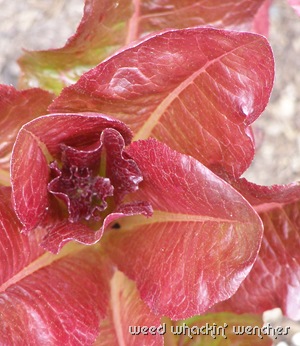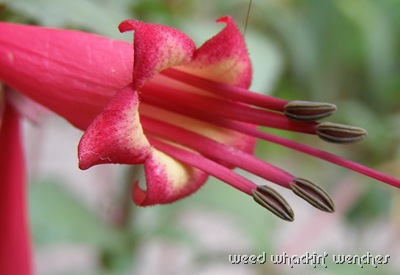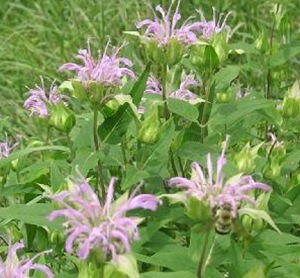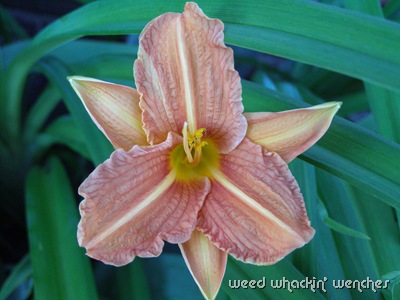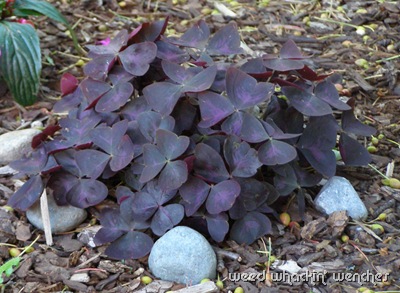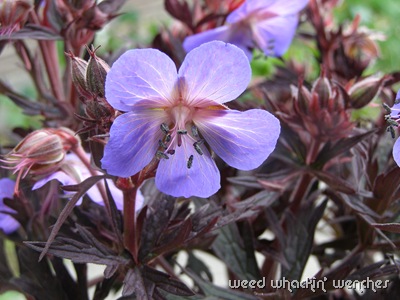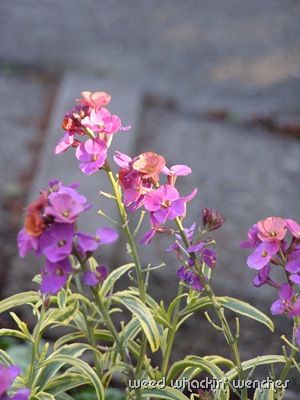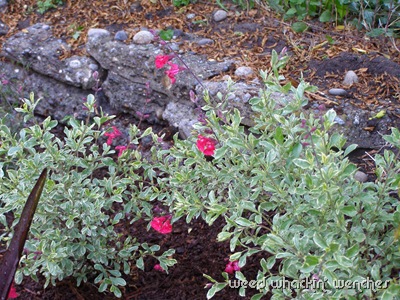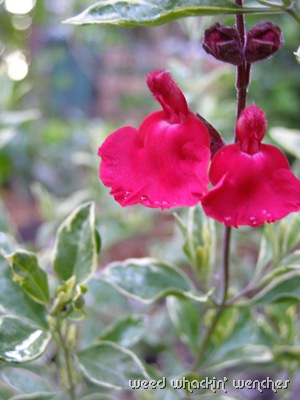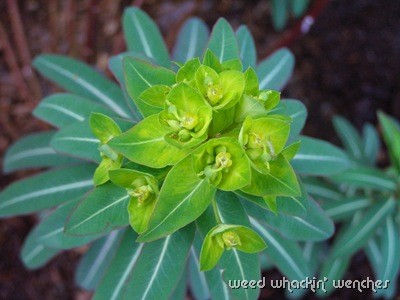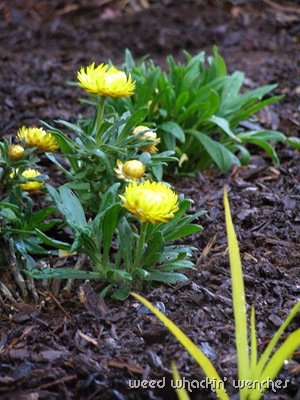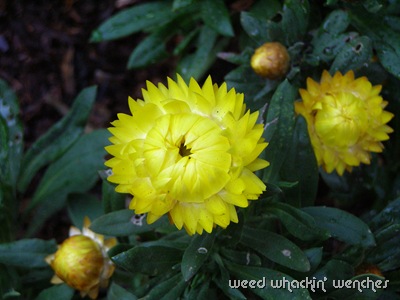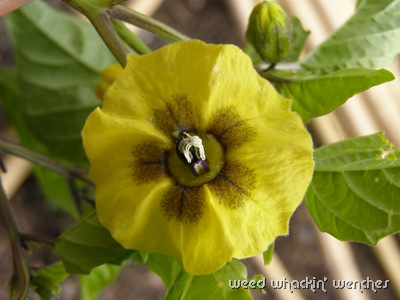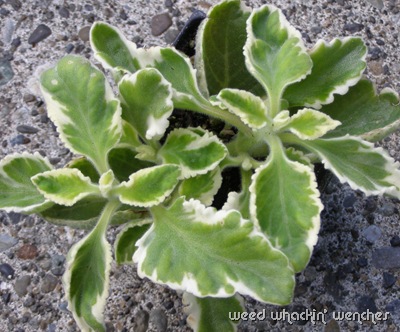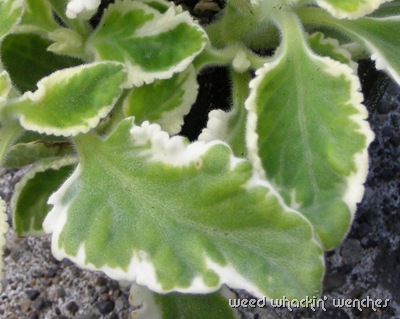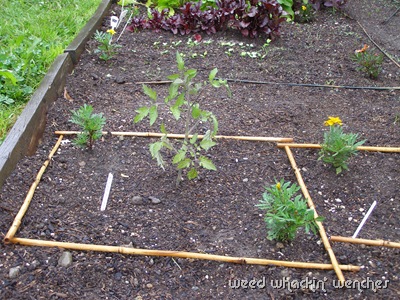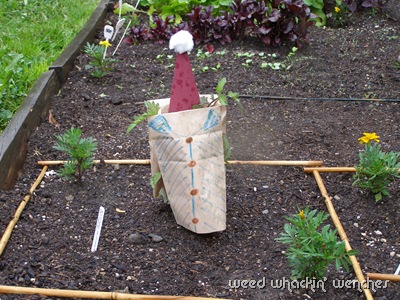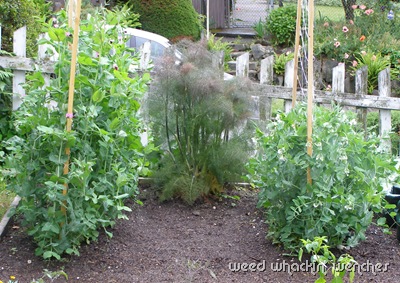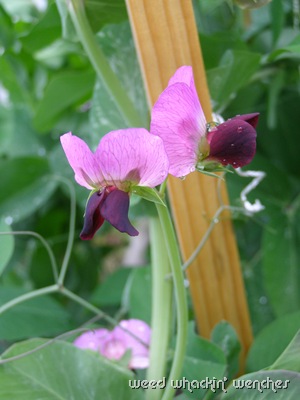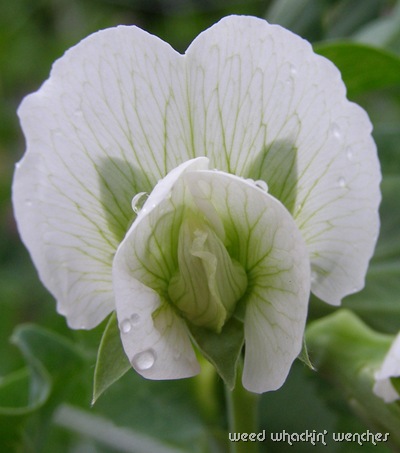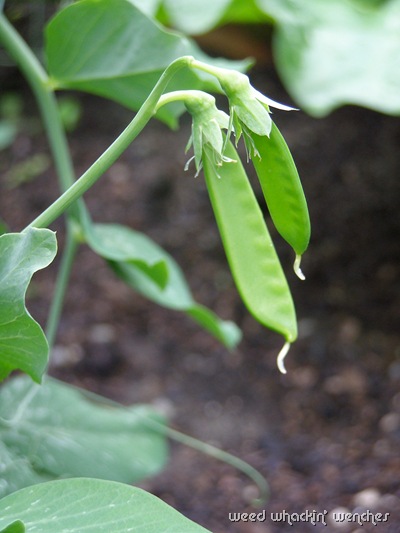Can you guess what they are?
Wednesday, June 25, 2008
Tuesday, June 24, 2008
Déjà Tagged
--Didn't we JUST do this???
--Well, actually, we did this back in March. And since then we've ignored a couple of tags.
--Oops. Alright, alright. Here goes. But we're going to be BORING and stick to garden factoids.
THE RULES
1. Post the rules.
2. Write six random things about yourself.
3. Tag six people.
4. Let the people know they've been tagged.
5. Let the person who tagged you know you post is up.
THE FACTOIDS
We've only killed one perennial and a few annuals this year. R.I.P the Australian mint bush, some verbena, one purple cauliflower plant. Not dead yet, but looking less than green, are the baby bay tree and the agastache rupestris 'sunset hyssop.'
We have the world's ugliest hedge along with some of the fugliest shrubs we've ever had the misfortune to lay eyes on. Seriously.
We've FINALLY figured out how to start tackling the western border of the yard. The goal is a bed with reds, oranges & yellows. Daylilies, cape fuschia and monarda will get us started.
We have so-called 'dwarf' grey sugar snow peas towering over the monstrous bronze fennel and exceeding the top of the 6ft trellis. The beautiful purple blossoms are giving way to many green pods.
Because we love to cook, we have 4 thymes (variegated lemon, orange balsam, silver posiee, and Foxley), 4 sages (garden, tri-color, pineapple and purple), and 4 mints (peppermint, pineapple, orange and ginger).
And finally, in the interest of world peace and domestic harmony, it is best if we work on construction projects, such as building the cloche, separately.
WHO WE'RE TAGGING
YOU! If you're reading this, and this sounds like a fun activity, then we invite you to play along.
Monday, June 23, 2008
Pennsylvania Dutch Traditions and Festivals
Life is full of funny and wonderful surprises. While reading Eating Well magazine and enjoying my morning coffee, I discovered an article about Whoopie Pies. Imagine that! A classic Amish and PA Dutch favorite treat of my childhood featured in a national healthy eating magazine. Of course the good folks at Eating Well magazine adjusted the recipe to make it healthier... I'll have to try it and see if the new version is as tasty as the old.
Photo from What's Cooking America
What's a Whoopie Pie, you ask? It's a delicious treat made of two chocolate cake-like cookies and a fluffy white filling. Where did the name come from?
According to Amish legend, when children would find these treats in their lunch bags, they would shout "Whoopie!" (whatscookingamerica.net)
I'd certainly shout "Whoopie" if Curmudgeon put one if my lunch bag!
I also read about an annual Whoopie Pie Festival at the Hershey Farm in Lancaster, Pennsylvania. I had no idea! I just might have to head back to visit in September and enter myself in the Whoopie Pie Eating Contest or the Whoopie Yell Off.
Speaking of festivals, the Kutztown Pennsylvania German Festival is coming up soon (June 28 to July 6). This festival celebrates and recreates the folklife of the Pennsylvania Dutch (German farmers and settlers) of Berks County. The photo below is one of the prize winning quilts from 2007. Click on the quilt to see more of the 2007 winners.
Growing up nearby, attending this festival was an annual summer event. "Eat 'til you ouch" signs hang over many of the food stands. Trust me - that is quite easy to do! The festival features many delicious, traditional PA Dutch foods, including chicken pot pie, schnitz un knepp (dried apples, ham and dumplings), sausages, potato filling, pepper cabbage, chow chow (pickled veggies), milich flitche (milk pie), shoofly pie and birch beer. I grew up eating many of these dishes and introduced Curmudgeon to them  when we visited the festival two summers ago. She turned to my mother frequently and asked her while pointing at me, "Does she know how to make this? Can you give her the recipe?"
when we visited the festival two summers ago. She turned to my mother frequently and asked her while pointing at me, "Does she know how to make this? Can you give her the recipe?"
In addition to the food, the festival features handmade arts and crafts, incredibly beautiful quilts, hex signs, music and dancing, farming tools and implements, and barnyard babies for children to meet.
(Banner, quilt, pickled veggies and hex sign photos above are all from the Kutztown Pennsylvania German Festival website)
Wing Nut's mother is a craftswoman at the festival. She is a seamstress and makes the world's best baby bibs, beautiful aprons, placemats & table runners in a variety of fabrics for every holiday or season, Christmas tree skirts, handy kitchen towels and much more. Her business name is Bib-A-Lot. If you stop by and say hi, tell her the Weed Whackin' Wenches sent you.
Saturday, June 21, 2008
Devil made me do it
Oreilles du diable / Devil's Ears
Devil's Tears
The first is a tasty and beautiful red leaf lettuce that is flourishing in our potager. So far, it is retaining a slightly sweet and pleasant taste while others are getting bitter.
The second is a beautiful new addition to our perennial hummingbird garden. Hopefully this cape fuschia (phygelius) will attract more hummers for us to enjoy.
Thursday, June 19, 2008
Bergamot & Bergamot
I learned something most interesting today. There is bergamot and then there is bergamot. One is a citrus fruit and the other is an herb in the mint family.
Being a long-time fan of Earl Grey tea, I was familiar with Bergamot oranges.
image from Wikipedia
The Bergamot orange is believed to be a cross between the Seville orange and the pear lemon. The resulting fruit is green when young, maturing to a yellowish orange with a distinct nipple at one end. It is rather small and very sour--inedible really. It is the essential oils in the rind of this citrus fruit that are used to flavor Earl Grey tea. My favorite Earl Grey is "Double Bergamot Earl Grey" from the Stash Tea Company of Tigard, Oregon. Today 93% of the bergamot orchards are to be found in Calabria, Italy and the Ivory Coast.
In France essence of bergamot is much used in candy making. In the city of Nancy there is a specialty known as Bergamote de Nancy. So special are these unique golden candies that they have been granted an I.G.P. by the European Union. I.G.P. stands for Indication Géographique Protégée or Protected Geographical Indication (P.G.I.) in English. For a photo of the Bergamot orange check out Chocolate & Zucchini. If your French isn't too rusty check out Cuisine Campagne for a crêpe recipe or one for Petit gâteaux moelleux à la bergamote et à l'huile d'olive. For the more scientifically inclined, here is a most interesting article from Culture, Science, Chimie. And for the economically inclined, this 2006 article from the BBC about the bergamot growers in Calabria.
Now for the other bergamot, Monarda.
Image from Wikipedia
From the mint family and a native of North America, Monarda has many names.
- Monarda didyma: Oswego Tea, Scarlet Monarda, Bee Balm, Blue Balm, High Balm, Low Balm, Mountain Balm, Mountain Mint, Bergamot
- Monarda fistulosa: Bee Balm, Bergamot, Horsemint, American Horsemint, Long-flowered Horsemint, Purple Bergamot, Oregano, Plains Bee Balm, Fern Mint
- Monarda punctata: Horsemint, Spotted Monarda, Monarda Lutea, Wild Bergamot
And while we're on the topic of names, the genus "Monarda" was named for Nicolás Bautista Monardes (1493-1588), a botanist and physician from Seville, Spain. Even though he never traveled to North America, Monardes studied many of the plants from the "New World" right in his garden in Seville. He had easy access to these plants as Seville controlled navigation and commerce in the 16th century. Monardes' major work was his herbal, Historia medicinal de las cosas que se traen de nuestras Indias Occidentales, published in three parts between 1565 and 1574.
In North America Monarda has a long history of medicinal use among the Ojibwe, Lakota, Chippewa, Crow, Winnebago, Blackfeet, Menominee and Navajo. Its properties include antiseptic, anti-inflammatory, antispasmodic, diuretic, among others. It has been used for fevers, colds, coughs, eye pain, headaches, nausea, vomiting, flatulence, acne, skin eruptions, insect bites and stings, swelling and rheumatic pain.
Now how did the herb and the citrus come to share a name? Supposedly the tea made from the herb was introduced to the colonists by the Oswego Indians around about the time of the Boston Tea Party. The citrusy aroma was reminiscent of the beloved Earl Grey and thus a new tea was adopted and a name was bestowed.
I have Jane Marie of Thyme for Herbs and her Burpee cap giveaway to thank for inspiring my research adventure and leading me to discover a new plant.
Tuesday, June 17, 2008
Don't cry for me Argentina!
Don't cry for me Argentina
The truth is I never left you
All through my wild days
My mad existence
I kept my promise
Don't keep your distance
Evita, 1978. Frank Lloyd Weber/Tim Rice
I wonder if there are many homesick Argentines in my neighborhood? I wonder if they miss the flora of their homeland so much that they have attempted to grow some of their native plants here in the urban landscape of Seattle? I wonder if plants really do get lonely and if that's why people always plant things in twos or threes or fours? Inquiring minds want to know. Okay, maybe I'm the only one who wants to know.
Allow me to introduce cortaderia selloana.
This is a magnificent, noble, graceful plant. Definitely a jaw dropping, head turning, show-stopping, car accident causing, WOW! type of plant. For me this is an iconic grass species of Argentina. Alas, no, the above picture was not taken on a recent family trip to South America in search of fodder for our blog. I wish it were so, but sadly it is not. These two beautiful specimens, along with about a dozen others, are to be found right in our neighborhood.
Cortaderia selloana is commonly known as pampas grass. Before I knew better, I thought it was "pompous" grass. Granted, this is definitely grass with attitude. "Pampas," from the Quechua language, means "plains." The pampas are the fertile lowlands of South America extending from Argentina to Uruguay and the southernmost part of Brazil. Cortaderia selloana grows to a height of 12' and a spread of 8'. The leaves are only 1/2 to 3/4 of an inch wide but can be as long as 6' and the edges of the leaves are very sharp, sharp enough to cut. Cortaderia selloana is often confused with cortaderia jubata. According to the ANR database at UC Davis' website, the latter differs in its ability to produce viable seeds--over a million in a plant's lifetime--while the former does not produce viable seeds as most plants are female and only those with working male parts can produce viable seeds. However nurseries have been propagating these plants to have more working male parts.
I wonder if botanists and horticulturalists in South America are shaking their heads and laughing, "Gringos locos!"? I wonder if bulldozer pruning is soon going to replace shovel pruning in our neighborhood?
Sunday, June 15, 2008
Garden Bloggers' Bloom Day--June 2008
We'd like to dedicate this edition of GBBD to a very special step-dad. HAPPY FATHER'S DAY! We hope you enjoy the bouquets from our garden. As usual, we're a bit late but a card IS on its way!
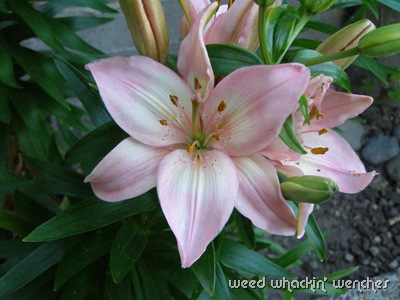
June is lily month in our garden and both the Asiatic lilies and the daylilies cooperated by opening their first bloom just in time for GBBD.
In the shade garden we have two dark-leaved surprises. First, the purple oxalis returned from the dead. Two winters ago we forgot where it was and we plunked the bird bath on top of it. Last summer it put out a couple of anemic pink leaves and then died. We didn't expect it back. But here it is! The second surprise is a new addition this year, hardy geranium 'Midnight Reiter'.
On the hillside the plants are filling in nicely. Everything is full and lush. Right now only a few things are in full bloom. The wall flower is providing much visual interest with its bi-colored flowers and its variegated foliage. And it smells wonderful. Another plant with variegated foliage on the hillside is this sage. It has very delicate foliage and tiny but eye-catching bright flowers.
Euphorbia 'Excalibur' is looking like a funky palm tree since it lost its bottom leaves after all the recent rains. The white Spanish lavender is keeping the bees very happy. We are seeing lots and lots of bees in our garden this year.

The strawflowers returned even though they were tagged as "annual" Shorter than most everything else on the hill, they hold their own with that shock of bright yellow color. Below, one final flower, this one from our potager. Can you guess what it is?
This is our first tomatillo flower!!!
For more Garden Bloggers' Bloom Day posts from around the world visit Carol at May Dreams Gardens.
Sunday, June 8, 2008
Cuban Oregano
If you were to ask me what my favorite day of the week is, I would reply without hesitation THURSDAYS. Thursdays make me smile and dance with glee. I spend the day full of A-N-T-I-C-I-P-A-T-I-O-N because Thursday is the day when new plants find their way to our garden as Wing Nut often does a little shopping before heading home at the end of her work week.
This week was "hyper" special because Cuban Oregano came to live with us. It has always been a treasure hunt when we settle in a new place to find him. The nice, but often clueless, nursery people always try to sell me on Greek, Italian or, GASP, Puerto Rican varieties. Here in the PNW I've been looking to cross paths with Cuban Oregano for 4 years now. When in NE, it took me 2 years to find him. So far, with enough patience and persistence--and some educating of the nursery staff--I have always been able to find him.
Isn't he spectacular? The Greek and Italian varieties are so insubstantial when compared to this plant. The leaves and stems of Cuban oregano are thick and fleshy and hairy. When you rub them with your fingers, the aroma of the leaves is out of this world.
This is a very important culinary herb in the Caribbean. In Cuban cooking, it is used to flavor black beans and roasted pork, to infuse oils or vinegars, to garnish salads or drinks. It also has medicinal uses. In Cuba the curanderos (healers) and yerberos (herbalists) use this plant to help with digestive ailments, bronchitis and rheumatoid arthritis.
If you ask any Cubans they will swear that this is the verdadero or real oregano. The first irony is that it is not a true oregano. This is plectranthus amboinicus, a member of the mint family and a relative of the garden coleus. The second irony is that it is not native to Cuba but rather to southeast Asia. Some sources say Africa but I've found numerous references to this plant in Vietnamese herb/cooking books. In Cuba it is called "orégano de la tierra" or "orégano francés," the latter pointing to Haiti as a point of introduction. It most likely was introduced in Haiti during the French colonial period. Adding to the difficulty of tracking down this plant are its numerous other names--Spanish thyme, French thyme, Mexican mint, Indian mint, soup mint, Indian borage, country borage, and oreille (French for ear).
Cuban oregano is hardy only to zone 10 so I have always grown it as an annual. It continues to look its best in the hottest part of summer even when kept in full sun. I've read that it can grow to 2' though I've never had one that grew that much. Plucking leaves and stems for culinary use helps the plant maintain a nice compact bushy shape.
I'd love to hear from anyone who has grown this plant. Do you grow it as an ornamental or as an herb and under what conditions? If grown as an herb, how do you use it?
Wednesday, June 4, 2008
Just because the calendar says it's June...
does not mean it's warm here. I spent Sunday, June 1st, wearing a long sleeved T-shirt and heavy sweatshirt while at work.
It also does not mean we're out of the rainy season. I spent the day Tuesday, June 3rd, in rain gear while unloading trucks and hustling the delicate flowers inside to avoid being crushed by the heavy drops.
At home, the delicate flowers are in the ground, not pots, and so cannot be moved. So today, our verbascum is not a "perky" lass like she was the other day. Poor dear!
One of my customers asked me if the pepper and tomato plants came with jackets or sweaters this year. I laughed and said no, but that's a great idea! They sure need them this year.
"Hey lady, I'm a heat lover and I'm C-O-L-D!"
"Hey thanks! I'm warmer now. I look like a freakin' elf, but I'm warmer now."
-- Wing Nut
Tuesday, June 3, 2008
Mange-tout
The peas have been producing flowers galore. And today I spotted the first two peas on the shorter, white-flowering plants. Most exciting.
Dwarf Grey Sugar
Oregon Sugar Pod II
Sunday, June 1, 2008
Garden Bloggers' Muse Day--June 2008
I spy a blackberry vine. Can you find it? How many dandelions can you count? For more GBMD posts check out Sweet Home and Garden Chicago.
BACKYARD OPERA
I march through the yard with a hard eye,
yanking weeds, asserting a path,
incensed by the relentless advance
of honeysuckle and morning glory vines
weaving under everything like an insidious subtext,
determined to have their loopy, insensible say
even as I slash them back, seeking their polyphonous source,
my finite gestures meaning nothing to them,
as they know I will tire, drift back into the house
and forget our duet for days, even weeks,
letting them spin their tales, full of plot twists,
almost orchestrating my little bench into their melody,
so that when I finally cut back a spot and sit,
and the chimes pick up a phrase of wind,
it becomes clear I am just a half note of silence,
a pause in the longer song.
--Aleida Rodríguez, Garden of Exile, 1999


